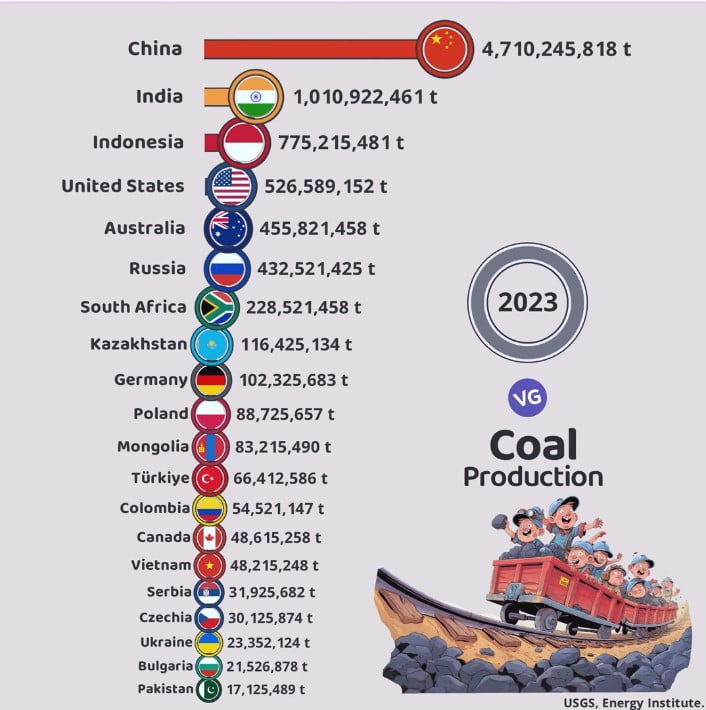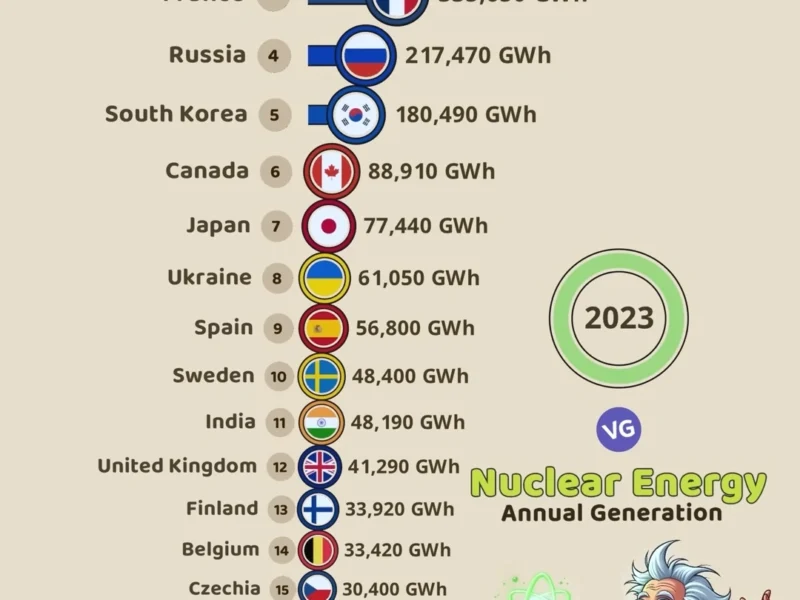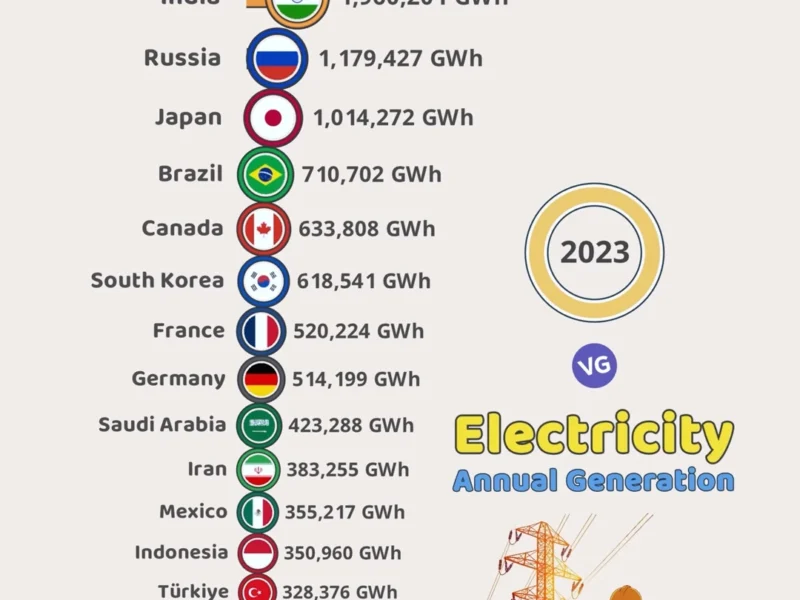The global coal industry is huge, pulling out millions of tonnes of coal every year. In 2021, the world produced a massive 8,067.2 million tonnes of coal1. This shows how big and important coal is as a key energy source.
Largest Coal Producers in The World 2023
| Flag | Country | Production (tonnes) |
|---|---|---|
| 🇨🇳 | China | 4,710,245,818 |
| 🇮🇳 | India | 1,010,922,461 |
| 🇮🇩 | Indonesia | 775,215,481 |
| 🇺🇸 | United States | 526,589,152 |
| 🇦🇺 | Australia | 455,821,458 |
| 🇷🇺 | Russia | 432,521,425 |
| 🇿🇦 | South Africa | 228,521,458 |
| 🇰🇿 | Kazakhstan | 116,425,134 |
| 🇩🇪 | Germany | 102,325,683 |
| 🇵🇱 | Poland | 88,725,657 |
| 🇲🇳 | Mongolia | 83,215,490 |
| 🇹🇷 | Türkiye | 66,412,586 |
| 🇨🇴 | Colombia | 54,521,147 |
| 🇨🇦 | Canada | 48,615,258 |
| 🇻🇳 | Vietnam | 48,215,248 |
| 🇷🇸 | Serbia | 31,925,682 |
| 🇨🇿 | Czechia | 30,125,874 |
| 🇺🇦 | Ukraine | 23,352,124 |
| 🇧🇬 | Bulgaria | 21,526,878 |
| 🇵🇰 | Pakistan | 17,125,489 |
A few countries lead the way in coal production. The top 10 coal producers in 2021 were named by the FAOSTAT, the United Nations, and the World Bank. They are:
- China – 4,126.0 million tonnes1
- India – 762.0 million tonnes1
- United States – 523.8 million tonnes1
- Australia – 467.1 million tonnes1
- Indonesia – 614.0 million tonnes1
- Russia – 435.3 million tonnes1
- South Africa – 235.7 million tonnes1
- Germany – 126.3 million tonnes1
- Poland – 107.4 million tonnes1
- Kazakhstan – 89.1 million tonnes1
Key Takeaways
- China leads in coal production, making over 50% of the world’s coal.
- Countries like India, the United States, Australia, and Indonesia also produce a lot of coal, making up over 30% of global production.
- European countries like Germany and Poland are also big coal producers, showing coal’s ongoing role in energy.
- The top 10 countries produce most of the world’s coal, showing the industry’s focus.
- The coal industry is expected to grow, with a 2.3% annual increase from 2021 to 2025.
Introduction to Global Coal Production
Coal Production by Country (2023)
Source: USGS, Energy Institute
The global coal industry has seen big changes lately. These changes reflect the shift in how we use energy around the world2. In 2022, coal use hit a record high, increasing by 3.3% to 8.3 billion tonnes2. China, India, and Southeast Asia will use 75% of the world’s coal in 20232. But, the US and the EU saw coal use drop by 24% and 16% in the first half of 20232.
Coal is still a key energy source, making up 27% of the world’s energy use and 35% of electricity in 20223. Yet, it faces big challenges as the world moves towards cleaner energy3.
Just a few countries lead in coal production4. China leads, holding about 13.2% of the world’s coal reserves4. The US has 23.7%, India 9.6%, and Australia is the top exporter with 14% of the reserves4.
The coal industry is changing, focusing on reducing emissions and improving safety3. As we move to cleaner energy, the future of coal production will greatly affect the energy world2.
| Country | Coal Reserves (% of Global) | Coal Production Rank |
|---|---|---|
| China | 13.2% | 1 |
| United States | 23.7% | 2 |
| India | 9.6% | 3 |
| Australia | 14% | 1 (Largest Exporter) |
| Indonesia | N/A | 2 (Largest Exporter) |
| Russia | 15.2% | 6 |
| South Africa | 0.9% | 7 |
| Kazakhstan | 2.4% | 10 |
| Colombia | N/A | 4 (Largest Exporter) |
| Ukraine | 7% | N/A |
“Despite environmental and health concerns associated with coal combustion, coal and electricity sectors have made advancements in emissions reduction, water treatment, land reclamation, and worker health and safety.”3
Understanding the trends, leaders, and challenges in the global coal industry is key to its future2. The data here gives a full view of the coal market, helping those in the industry and policymakers3.
China: The World’s Largest Coal Producer
China leads the world in coal production, making up over 51% of global output in 20215. It produced 4,126.0 million tonnes of coal, a 5.7% increase from the year before5. This is thanks to its vast coal reserves and its need for coal to meet energy demands.
China’s Dominance in Coal Production
In 2018, China produced 1,829 Mtoe of coal, more than the next nine top producers combined5. This made up 46.7% of global production5. China is clearly the top coal producer in the world5.
Environmental Impacts and Challenges
China’s use of coal has caused big environmental problems, like air pollution and high greenhouse gas emissions. In 2022, China emitted over 4.5 billion tonnes of carbon dioxide from coal-fired power5. Despite plans to use more renewable energy, China still invests in coal, adding 43 new coal power units in the first half of 20215.
The government has set goals to cut coal use and boost renewable energy6. But, changing from coal is hard, as it makes up 57% of China’s energy use, with 49% for power5. The National Development and Reform Commission wants to keep coal use under 3.8 billion tonnes a year5. Yet, China’s huge energy needs keep it relying on coal.
China’s coal industry also deals with water and air pollution, land subsidence, soil erosion, and gas emissions6. These issues highlight the need for a balance between energy and the environment.
“China is the largest importer of coal globally, with imports coming predominantly from Russia and Indonesia during the 2020s.”5
India: A Rising Coal Giant
India is the world’s second-largest coal producer, playing a big role in global energy7. Its coal industry is growing fast, thanks to the increasing energy needs of its booming economy7. Coal India, a state-owned company, aims to produce 1 billion tonnes of coal by 2025-26, reaching 773 million tonnes last year7.
India’s Coal Production and Consumption
India’s coal production has seen a big jump, rising by 14.5% in June 20248. Coal India Ltd, which makes up about 80% of the country’s coal, increased its output by 8.9% in the same period8. Also, coal stockpiles at Indian companies and thermal power plants have grown by 42% and 30%, respectively, in June 20248.
This increase in domestic coal production has led to a drop in India’s coal imports over the last decade8. Experts predict a decrease in thermal coal imports in 2024 due to more domestic coal and high stock levels8. Many coal users in India are now using more domestic coal, reducing their reliance on imports8.
Yet, India still depends a lot on coal, which makes up about 70% of its power generation7. This heavy use of coal raises big environmental issues, like air pollution and greenhouse gas emissions7. As India grows its coal industry, finding a balance between energy security and environmental concerns is key.
“India’s coal industry is a double-edged sword, providing essential energy while also contributing to environmental challenges. Striking the right balance is crucial as the country continues to develop and grow.”
United States: A Declining Coal Powerhouse
The United States was a top name in the global United States coal industry. But, its influence has been fading over the years. In 2021, the US made 523.8 million tonnes of coal, up 7.8% from 2020. Yet, this is way less than the 1 billion tonnes produced in 20089. The drop in coal production is due to more natural gas and renewable energy, tougher environmental laws, and coal industry’s economic troubles.
Historical Role and Current Trends
Coal has been crucial to the United States’ history, with Appalachia leading in coal extraction since 18009. Pennsylvania alone has produced 1/5 of all coal to date9. Ohio, Illinois, and Indiana have also played a big part, making 16% of the country’s coal by 20229. But, the factors impacting US coal sector have changed the industry a lot.
In 2022, Wyoming’s coal mines made up 41% of the country’s coal production9. Two mines there, North Antelope Rochelle and Black Thunder, alone made 20% of the nation’s coal9. Coal production in Appalachia dropped by over 65% from 2005 to 2020, more than the national decline of 54%10. The coal industry lost about 54% of its jobs from 2005 to 2020, with most losses in Central Appalachia10.
“The decline of the US coal industry is a complex issue, with a variety of economic, environmental, and policy factors contributing to its diminishing role in the energy landscape.”
Even with these issues, the United States is still a big player in the global coal market. But, its leading role has been lessened by changes in the energy sector910.
Australia: A Major Coal Exporter
Australia is a big name in the global coal market, ranking fourth in coal production in 2021 with 467.1 million tonnes11. It’s the top exporter of metallurgical coal and the second-biggest exporter of thermal coal, sending out 390 million tonnes in 2019-2011. The coal industry is key to Australia’s economy, offering jobs and making $112 billion from exports in the 2021-22 financial year11.
Australia leads the world in exporting coking coal and has nine major ports for coal exports. Newcastle, in New South Wales, is the biggest and most efficient coal port globally11. In 2021, coal made up 64% of Australia’s energy production and 32% of its energy use, showing its big role in the country’s energy mix11.
But, Australia’s use of coal raises big environmental worries, like greenhouse gas emissions and climate change. The coal industry is under pressure to switch to cleaner energy sources. This is to meet economic needs and tackle the global climate crisis12.
Despite challenges, Australia is still a big player in the global coal trade. It sends coal to major markets like Japan, China, and India. In 2020, coal exports made up 1% of Australia’s national revenue, showing how important the industry is11.
“Australia is the world’s second-largest coal exporter and holds the third-largest coal reserves globally.”12
The shift to renewable energy will keep Australia’s role in coal trade in the spotlight. This will spark ongoing debate and interest worldwide12.
Indonesia: A Significant Coal Producer
Indonesia is the fifth-largest coal producer globally, producing 614.0 million tonnes in 202113. Its coal production has grown a lot, from 13 million tons in 1991 to over 606 million tons in 202114. The country has coal reserves that could last about 83 years at current production levels. These reserves are mainly found in South Sumatra, South Kalimantan, and East Kalimantan15.
Indonesia’s Coal Exports and Domestic Consumption
Indonesia exports a lot of coal, sending 70-80% of its production to countries like China, India, Japan, and South Korea15. But, it’s also using more coal at home, with consumption rising to 745.72 million barrels of oil equivalent (BOE) in 202213. This increase has led to a 20% rise in carbon emissions from fossil fuels13.
Most of Indonesia’s new energy capacity, 20 GW out of 35 GW, comes from coal plants13. In 2021, the country’s power plants had a capacity of 74 GW, with 50% or 37 GW from coal14. This makes Indonesia one of the world’s top emitters of fossil CO2, likely to rank sixth globally, after Japan13.
The Indonesian government wants to use more renewable energy, but coal is still a big part of its energy mix. They aim to have coal supply around 30% of its energy mix by 202515. But, the use of coal has big environmental problems, like air pollution and premature deaths, in Indonesia14.
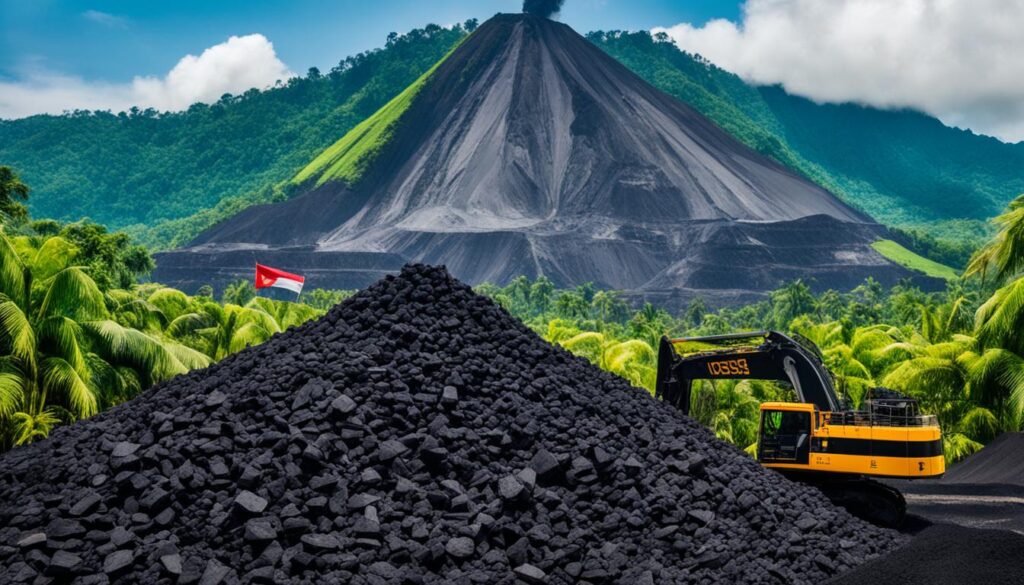
“Indonesia, as the world’s third-largest coal producer, and a major consumer is poised to see a continuous rise in coal consumption through 2029.”13
Russia: A Prominent Player in Coal Production
Russia is the sixth-largest coal producer globally, producing 435.3 million tonnes in 202116. It has vast coal reserves and has been key in the global coal market for years17. The coal industry is crucial for Russia’s economy, offering jobs and income. Yet, it faces issues like environmental concerns and moving to cleaner energy.
In 2020, Russia used 7,863 TWh of energy and emitted 11.2 tCO2 per person17. It holds the second-largest coal reserves, with 157 billion tonnes17. Even after losing 75% of its energy exports to Europe in 2022, Russia still plays a big role in coal production17.
Recently, Russia has been boosting coal exports to Asia, especially China, due to less demand from Europe17. As the third-largest coal exporter, it aims to diversify its energy sources, but hydropower makes up only about 20% of its energy17. Russia’s impact on the global coal market is still strong, and its ability to adapt to energy changes will be key in the future.
| Country | Average Annual Coal Production (million metric tons) |
|---|---|
| Mexico | 6.2 |
| Brazil | 7.5 |
| Pakistan | 9.8 |
| Greece | 14.0 |
| Thailand | 13.7 |
| Romania | 18.2 |
| Ukraine | 16.5 |
“Russia is the world’s third-largest coal exporter, but has faced challenges in diversifying its energy mix, with hydropower accounting for only about 20% of its energy production.”
South Africa: A Leading African Coal Producer
South Africa is a big name in the global coal industry, ranking seventh in the world18. Its coal industry is key to its economy, offering jobs and income18. In 2018, it was the seventh-largest producer and consumer of coal worldwide18.
South Africa’s Coal Industry and Challenges
South Africa has been steady in coal production, making over 255 million tonnes in 2011 and using most of it at home18. The industry employed about 80,000 people in 2015, making up 0.5% of all jobs18. About 77% of South Africa’s energy comes from coal18.
But, the industry has big challenges. It’s the fifth biggest coal exporter, with 30% going to other countries18. South Africa makes 92% of Africa’s coal18. Using so much coal also raises environmental worries, as it’s behind 80% of South Africa’s CO2 emissions, producing 42GWs18.
The coal and lignite mining in South Africa made R39 billion in 2004 and employed 50,000 people directly18. The top five coal mining companies in South Africa produce about 85% of all coal18. Open-pit mining is used in about half of South Africa’s coal mining18.
South Africa needs to move to sustainable energy sources while keeping the coal industry’s economic and job benefits19. The country’s heavy use of coal power and its environmental effects are major concerns19.
biggest coal producers in the world
The global coal industry is a big part of the world’s energy scene. It has major players that shape how we use this important fuel. The top coal producing countries show a mix of big producers, each with their own unique challenges and strengths1.
China leads as the biggest coal producer, making 4,126.0 million tonnes in 20211. India is close behind, producing 762.0 million tonnes, making it a key player in coal production1. The United States, once a top producer, now ranks third with 523.8 million tonnes1.
Australia is a big exporter of coal, producing 467.1 million tonnes. Indonesia also plays a big role, making 614.0 million tonnes1. Russia adds 435.3 million tonnes to the global coal supply1.
| Rank | Country | Coal Production (million tonnes) |
|---|---|---|
| 1 | China | 4,126.0 |
| 2 | India | 762.0 |
| 3 | United States | 523.8 |
| 4 | Australia | 467.1 |
| 5 | Indonesia | 614.0 |
| 6 | Russia | 435.3 |
| 7 | South Africa | 235.7 |
| 8 | Germany | 126.3 |
| 9 | Poland | 107.4 |
| 10 | Kazakhstan | 89.1 |
The top coal producing countries show the varied nature of global coal production. Each country faces unique challenges and has its own opportunities in this changing energy sector20. As we deal with the environmental effects of coal, these leading producers will be key in shaping the future of energy and sustainable development20.
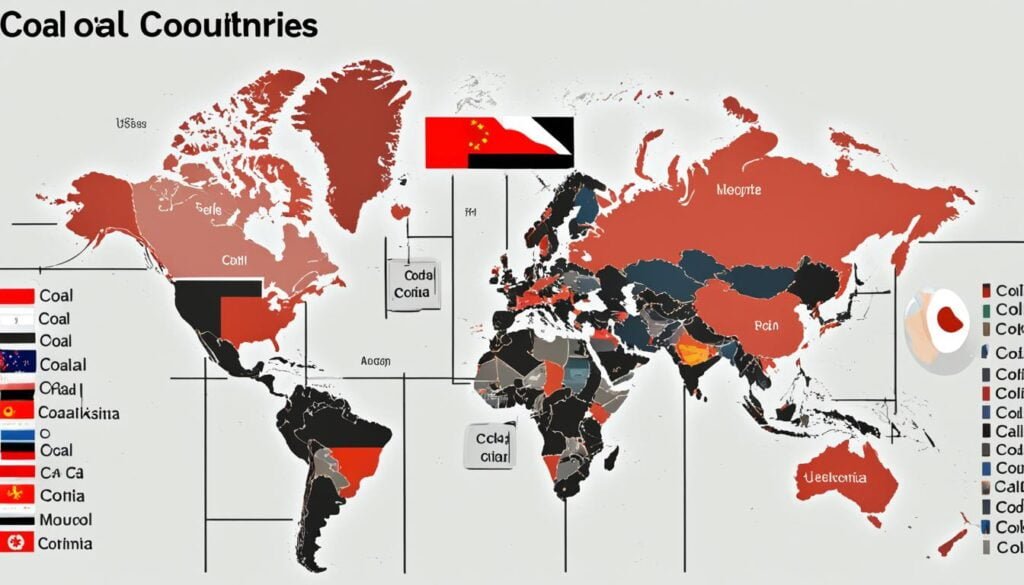
Germany and Poland: Major European Coal Producers
Germany and Poland lead in coal production in Europe. In 2021, Germany produced 126.3 million tonnes, and Poland produced 107.4 million tonnes21. Yet, they are cutting back on coal as they move to renewable energy.
Germany’s Transition to Renewable Energy
Germany aims to stop using coal for power by 203821. This big change is hard for the coal industry, as coal use dropped by 28% in five years to 160 million tonnes in 202221. Hard coal production in the EU fell by 80% since 1990, with Poland and Czechia now the main producers21.
Germany’s move to renewable energy is key, as it used 45% of the EU’s brown coal in 202221. The shift is needed, as most coal in the EU was used for power in 202121.
Germany’s effort to use less coal is a big step towards a sustainable future for Europe.
| Metric | Germany | Poland |
|---|---|---|
| Coal Production (2021) | 126.3 million tonnes | 107.4 million tonnes |
| Coal Consumption (2022) | 45% of EU total brown coal | 63% of EU hard coal consumption |
| Coal’s Share in Electricity Generation | 52% of hard coal, 92% of brown coal | Over 60% in 2023 |
| Coal Transition Challenges | Phasing out coal-fired power by 2038 | 75% of coal imports from Russia in 2022 |
Germany and Poland are key in Europe’s coal scene, facing big challenges in switching to sustainable energy2122.
“Coking plants in the EU consumed 41 million tonnes of coking coal to produce 31 million tonnes of coke oven coke in 2021.”
The EU’s climate goals mean big changes for Germany and Poland’s coal industries. They must adapt to new energy needs.
Emerging Coal Producers: Kazakhstan, Colombia, and Vietnam
Big names like China, India, and the United States lead the global coal market. But, countries like Kazakhstan, Colombia, and Vietnam are also stepping up their coal production. They’re showing that new players are entering the global coal scene.
Kazakhstan made 89.1 million tonnes of coal in 2021, ranking 10th worldwide23. Colombia and Vietnam produced 56.2 million and 47.8 million tonnes, respectively. These numbers show how important these countries are becoming in the coal industry23. As energy demand grows, especially in these fast-growing economies, these countries could become key players in the global coal market.
| Country | Coal Production (million tonnes) | Ranking in Global Coal Production |
|---|---|---|
| Kazakhstan | 89.1 | 10th |
| Colombia | 56.2 | Not Ranked |
| Vietnam | 47.8 | Not Ranked |
The rise of these new coal producers shows how the global energy scene is changing23. The world is facing challenges in moving to renewable energy sources. The role of coal producers, both old and new, will be crucial in meeting the world’s energy needs.
“The growth of emerging coal producers like Kazakhstan, Colombia, and Vietnam underscores the dynamic nature of the global coal market. As the world’s energy needs continue to evolve, these new players will undoubtedly play an increasingly significant role in shaping the future of the coal industry.”
Conclusion
China leads the global coal industry, making up over 53% of the world’s coal use24. It’s expected to grow by 2% in coal-fired electricity generation in 202224. India, the United States, Australia, and Indonesia are also big players24. China and India are the top consumers, producers, and importers of coal.
Coal is a key energy source, providing over 36% of global electricity and 27% of the world’s primary energy in 201925. Yet, the industry faces big challenges like environmental concerns and the shift to renewable energy24. In 2022, coal demand is set to hit a record high, but its use in the industry is expected to drop slightly24.
The world is moving towards a sustainable future, changing coal’s role in energy24. Demand is expected to stay steady at around 8 billion tonnes through 202525. The U.S. is a big emitter of carbon dioxide, but coal mining there supports nearly 150,000 jobs and uses almost all fossil fuel reserves25. The future of coal will depend on balancing energy needs with the environment. Some countries, like Germany, are cutting their coal use.
FAQ
What are the top 10 coal producers in the world?
The top 10 coal producers in 2021 were:
1. China – 4,126.0 million tonnes
2. India – 762.0 million tonnes
3. United States – 523.8 million tonnes
4. Australia – 467.1 million tonnes
5. Indonesia – 614.0 million tonnes
6. Russia – 435.3 million tonnes
7. South Africa – 235.7 million tonnes
8. Germany – 126.3 million tonnes
9. Poland – 107.4 million tonnes
10. Kazakhstan – 89.1 million tonnes
How has global coal production been affected by the COVID-19 pandemic?
The COVID-19 pandemic led to a 4.8% drop in global coal production in 2020. China was the only major producer to increase coal production, by 1.1%. The US and EU saw declines, especially in Germany, Poland, and Greece. Russia, Indonesia, India, and Turkey saw production growth but now face declines.
What is China’s role in the global coal industry?
China leads the world in coal production, producing 4,126.0 million tonnes in 2021. This accounts for over 51% of global production. Its vast reserves and energy needs make it a key player. Yet, its coal use raises environmental concerns, like air pollution and greenhouse gases.
How important is coal to India’s energy mix?
India is the second-largest coal producer, making 762.0 million tonnes in 2021. Coal fuels about 70% of India’s power. Despite efforts to diversify, coal remains crucial, posing environmental challenges.
What is the status of the coal industry in the United States?
The US was once a top coal producer but has seen a decline. In 2021, it produced 523.8 million tonnes, up from 2020 but still lower than its peak. Factors like natural gas and renewable energy, stricter rules, and economic issues have led to this decline.
What is Australia’s role in the global coal market?
Australia ranks fourth in coal production, making 467.1 million tonnes in 2021. It’s a big exporter, with a significant impact on its economy. However, its coal use raises environmental concerns, especially about greenhouse gases and climate change.
What is the role of Indonesia in the global coal industry?
Indonesia is the fifth-largest coal producer, making 614.0 million tonnes in 2021. It exports a lot of coal, mainly to Asia. Indonesia aims to increase renewable energy use but coal remains a key energy source.
What is Russia’s position in the global coal market?
Russia is the sixth-largest coal producer, making 435.3 million tonnes in 2021. It has vast coal reserves and a long history in the global market. The coal industry is crucial for Russia’s economy but faces environmental and energy challenges.
What is the role of South Africa in the global coal industry?
South Africa is the seventh-largest coal producer, making 235.7 million tonnes in 2021. Coal is a big part of its economy but faces environmental and renewable energy challenges.
What is the status of coal production in Germany and Poland?
Germany and Poland are major coal producers in Europe, making 126.3 million tonnes and 107.4 million tonnes, respectively, in 2021. But, they’re seeing coal production decline as they move towards renewable energy. Germany aims to end coal power by 2038, challenging its coal industry.
What are some emerging coal producers on the global stage?
Countries like Kazakhstan, Colombia, and Vietnam are emerging in the coal industry. They produced 89.1 million tonnes, 56.2 million tonnes, and 47.8 million tonnes of coal in 2021, respectively. As energy demand grows, these countries may play a bigger role in the global coal market.
Source Links
- List of countries by coal production – https://en.wikipedia.org/wiki/List_of_countries_by_coal_production
- Global coal demand set to remain at record levels in 2023 – News – IEA – https://www.iea.org/news/global-coal-demand-set-to-remain-at-record-levels-in-2023
- The history of global coal production – https://visualizingenergy.org/the-history-of-global-coal-production/
- Coal Production – an overview – https://www.sciencedirect.com/topics/earth-and-planetary-sciences/coal-production
- Coal in China – https://en.wikipedia.org/wiki/Coal_in_China
- Coal production efficiency and land destruction in China’s coal mining industry – https://www.sciencedirect.com/science/article/abs/pii/S030142071930011X
- EU “green” funds invest millions in expanding coal giants abroad – https://www.climatechangenews.com/2024/07/01/eu-green-funds-invest-millions-in-expanding-coal-giants-in-china-india/
- India’s Coal Production Jumped by 14% in June | OilPrice.com – https://oilprice.com/Latest-Energy-News/World-News/Indias-Coal-Production-Jumped-by-14-in-June.html
- The history of coal production in the United States – https://visualizingenergy.org/the-history-of-coal-production-in-the-united-states/
- An Overview of Coal and the Economy in Appalachia – Fourth Quarter 2020 Update (PDF: 2 MB) – https://www.arc.gov/wp-content/uploads/2021/04/Coal-and-the-Economy-in-Appalachia_Q4_2020-Update.pdf
- Coal in Australia – https://en.wikipedia.org/wiki/Coal_in_Australia
- Geoscience Australia – https://www.ga.gov.au/digital-publication/aecr2023/coal
- Indonesia’s coal burning hits record high — and ‘green’ nickel is largely why – https://news.mongabay.com/2023/07/indonesias-coal-burning-hits-record-high-and-green-nickel-is-largely-why/
- Unearthing Indonesia’s 10 biggest coal oligarchs – https://www.ekuatorial.com/en/2022/02/unearthing-indonesias-10-biggest-coal-oligarchs/
- Coal Mining in Indonesia – Indonesian Coal Industry – https://www.indonesia-investments.com/business/commodities/coal/item236
- 25 Largest Coal Producing Countries in the World – https://finance.yahoo.com/news/25-largest-coal-producing-countries-161852846.html
- Energy in Russia – https://en.wikipedia.org/wiki/Energy_in_Russia
- Coal in South Africa – https://en.wikipedia.org/wiki/Coal_in_South_Africa
- South Africa Coal Mining Industry Report 2023 with Company profiles of Leading Coal and Lignite Mining Companies and Coal Testing Laboratories – https://finance.yahoo.com/news/south-africa-coal-mining-industry-090800603.html
- These are the world’s biggest coal producers – https://www.weforum.org/agenda/2018/01/these-are-the-worlds-biggest-coal-producers/
- Coal production and consumption statistics – https://ec.europa.eu/eurostat/statistics-explained/index.php/Coal_production_and_consumption_statistics
- Coal in Poland – https://en.wikipedia.org/wiki/Coal_in_Poland
- Top 20 Coal Exporting Countries in the World – https://finance.yahoo.com/news/top-20-coal-exporting-countries-193844209.html
- Executive summary – Coal 2022 – Analysis – IEA – https://www.iea.org/reports/coal-2022/executive-summary
- Coal’s Importance to the World – Society for Mining, Metallurgy & Exploration – https://www.smenet.org/What-We-Do/Technical-Briefings/Coal-s-Importance-in-the-US-and-Global-Energy-Supp

